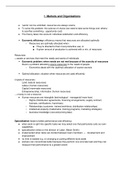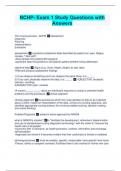Summary
Extensive Business for Lawyers Summary from 2021 (weeks 1-12)- recommended for final Exam
- Course
- Institution
The summary contains the weekly topics which are discussed throughout the course, as well as explanations, definitions, visuals and examples from the sessions to understand the concepts. This is the reason for the rather lengthy summary and hence covers every potential question which may be asked i...
[Show more]




